
Flying ants grow wings to leave their colony and start a new one. Unlike worker ants, only queens and males develop wings. This is a short phase, but it often happens in large numbers, drawing attention.
People usually notice flying ants on warm, humid days, especially in late spring or summer. This is the swarming season when winged ants fly to mate and spread. They can be seen near windows, porch lights, or even inside homes.
Not every ant with wings is a sign of an infestation. Their appearance is usually a normal, seasonal event. However, knowing which species you’re dealing with can help you decide if any action is needed. This blog identifies different types of ants with wings, explains why they swarm, and guides you on how to get rid of them.
7 Types of Ants With Wings
Flying ants, known as alates, develop wings, which are usually larger than those of the worker ants. The wings have a unique shape and structure, helping them take flight during the swarming season. Let’s discuss a descriptive picture of flying ants.
1.Carpenter Ants
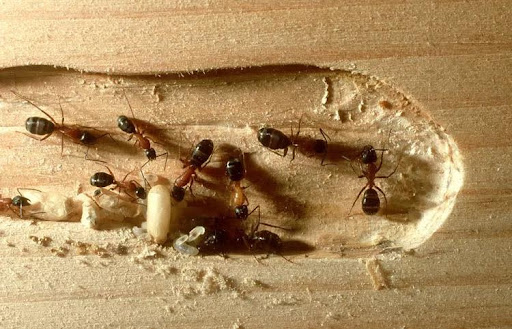
Source: https://www.thespruce.com/signs-of-carpenter-ants-in-house-11708948
Carpenter ants are one of the most common types of flying ants. They are larger and have black or reddish bodies. They usually swarm in the spring or summer, often after rain.
Carpenter ants with wings cause damage to wood. They don’t eat it, but instead tunnel through it to build nests, which can weaken the structural integrity. If you see carpenter ants with wings indoors, it could indicate an infestation. They often swarm around the home’s windows, lights, or damp areas.
Carpenter ants are attracted to damp or decaying wood, which makes homes with water damage especially vulnerable. While they don’t eat wood like termites, their tunneling can lead to significant damage over time.
2.Small Black Ants

Source: https://www.alabamawildlife.org/wonders-of-wildlife-little-black-ant/
Small black ants are tiny, measuring around 1.5 mm in length. Their dark brown to black color makes them easy to spot, although they often go unnoticed until swarming season, when they emerge in large numbers. During summer, especially after rainfall, they take flight in large numbers. They are seen gathering near windows or lights.
Inside homes, small flying ants swarm from wall voids, cracks, or baseboards. While these ants do not cause damage like carpenter ants or termites, they can be a nuisance indoors, especially during swarming periods. Their constant foraging for food indoors can also add to the problem. If you spot flying ants inside your house, identify the source and take steps to manage them before they become a larger issue.
3. Pavement Ants
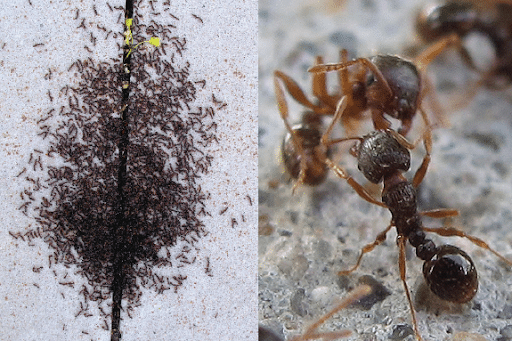
Source:https://extension.usu.edu/planthealth/research/pavement-ants
Pavement ants are small, usually 2–3 mm long, and are dark brown or black. They get their name by nesting in pavement cracks, driveways, and sidewalks. However, the nests of these flying ants can be in walls and other small spaces around your home.
Pavement ants have 12-segmented antennae. These small flying ants nest in kitchens or bathrooms, especially where food is present. They’re attracted to crumbs, sugar, and even dead insects. To prevent them from entering your home, ensure all entry points are sealed and maintain cleanliness in your living spaces.
4. Citronella Ants
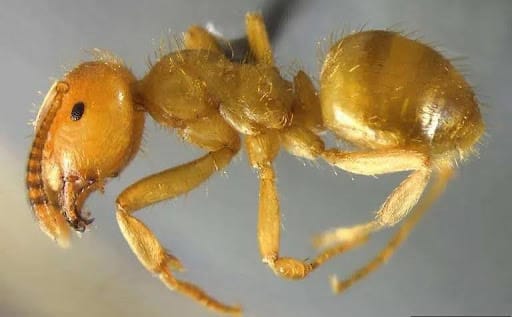
Source: https://extension.psu.edu/citronella-ants
Citronella ants are bright yellow and release a lemon-like odor when crushed, which is how they got their name. Many people confuse them with termites, especially when they swarm indoors.
These little ants with wings swarm typically in late summer or early fall, often following rainfall. Winged citronella ants emerge to mate, usually from nests beneath concrete, near foundations, or inside wall voids. They suck on the honeydew of subterranean plants and pose no risk to the human population. These California ants don’t bite, sting, or damage structures.
5. Fire Ants
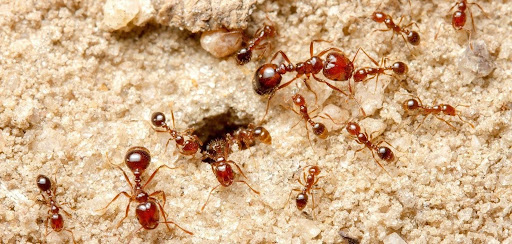
Source: https://cals.ncsu.edu/news/whats-in-fire-ant-venom-and-how-can-i-get-rid-of-fire-ants/
Originating from South America, these ants with wings have a reddish-brown appearance and are aggressive. Their painful stings cause burning, swelling, and, in some cases, allergic reactions. They build their nests in muddy mounds or leaf piles and use underground tunnels to navigate within the colony.
As part of their mating process, fire ants swarm during warm weather. New queens land shortly after swarming to establish fresh colonies. Fire ants will defend their nests fiercely, making them a risk in residential areas, especially around pets or small children.
Fire ants can be hard to control, especially in warmer climates like Southern California. Many homeowners seek help from pest control Orange County for safe and effective treatment. Professional help ensures proper identification and targeted removal.
6. Odorous House Ants
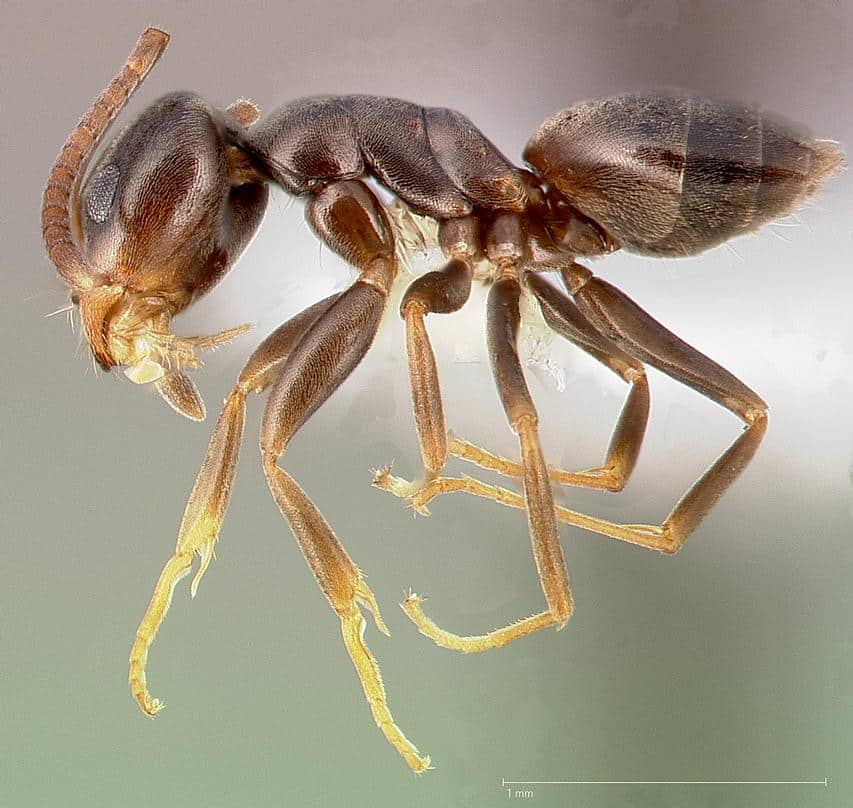
Source: https://insectlab.russell.wisc.edu/2019/04/24/identifying-insects-by-smell-part-2-odorous-house-ants/
Odorous house ants often enter homes searching for food, especially during warm months. They are small and dark brown, and when crushed, they have a distinct rotten coconut smell. People usually see them crawling on countertops or near sinks, but they may appear with wings during mating season.
They forage on sweet food. The winged version looks different from the regular workers. These winged sugar ants have larger bodies and delicate, wing-like structures that extend beyond their abdomens. Like other ants, they swarm in warm, humid conditions, often after rain. When swarming indoors, they can gather near windows, lights, or vents, making them easy to spot.
These ants do not damage buildings or furniture. However, their presence in kitchens and living spaces makes them a common household problem, as they can contaminate food. They nest inside wall voids, under floors, in insulation, and other hidden areas.
7. Black Garden Ants
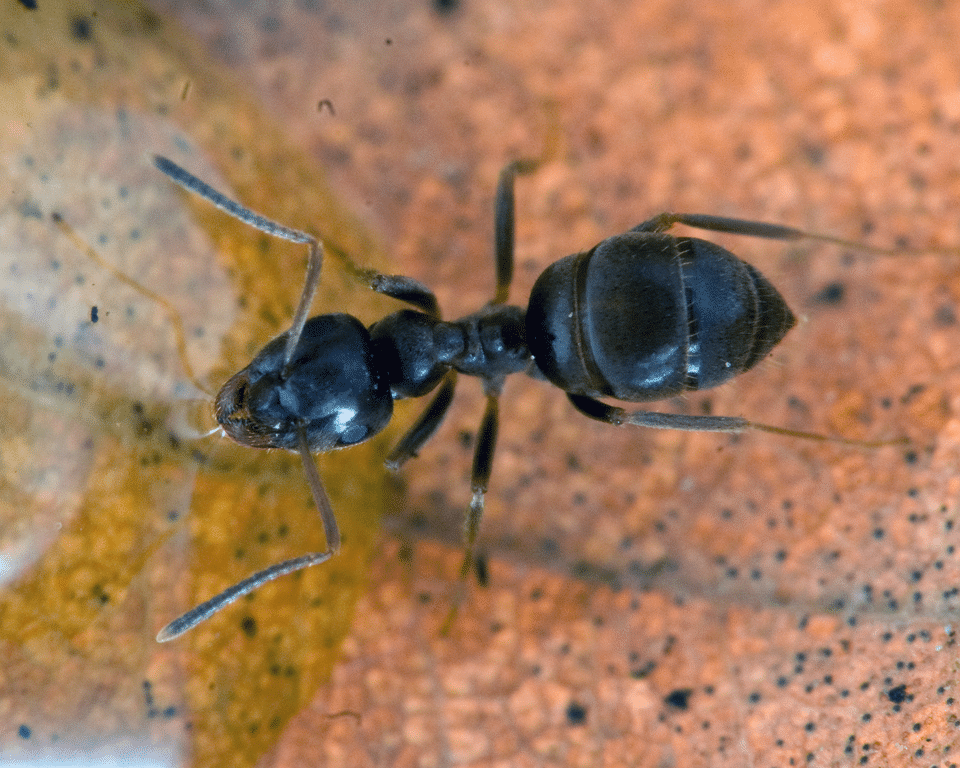
Source: https://www.wildlifetrusts.org/wildlife-explorer/invertebrates/ants/black-garden-ant
Black ants with wings are familiar in many gardens, especially in summer. In hot, humid weather, they gather in large swarms. This behavior is called a nuptial flight, where males and queens fly off to mate and establish new colonies.
These ants’ wings are transparent and slightly longer than their bodies. Swarms often happen all at once, creating sudden clouds of insects in gardens or sidewalks. Due to their small size, these tiny black flying ants can easily access homes and infiltrate food packaging.
How to Prevent and Get Rid of Flying Ants: 3 Strategies
Ants that fly can become problematic when they show up indoors or swarm in large numbers outside. While their presence might be seasonal, you don’t have to live with the disruption. Here are 3 simple ways to prevent these insects from settling near or inside your home:
1. Seal Entry Points and Eliminate Attractants
Ants invade your home through tiny cracks around doors, windows, or foundations. To reduce their access, seal these gaps with caulk or weather stripping. In addition, check that window screens fit properly and repair any damage.
Moreover, maintaining a clean environment discourages ants from entering. Clean surfaces to remove food particles and sticky residues. Since ants are especially drawn to sugars and oils, keep kitchen counters clean and store food in tightly sealed containers.
Moisture is another key attractant. Therefore, fix any leaking pipes, check under sinks for dampness, and keep basements or crawl spaces well-ventilated and dry.
2. Natural & Professional Remedies
Some people prefer natural options to keep flying ants away. You can try:
- Sprinkling cinnamon or peppermint oil around windows and doors
- Using vinegar-water sprays to clean surfaces and disrupt scent trails
- Placing lemon juice near known entry points
If these methods are ineffective, store-bought ant baits and sprays can help reduce the ant population. Always follow the label directions, especially when using products indoors.
3. Call a Professional
If you see repeat swarms or suspect an indoor colony, it’s best to seek professional help. A licensed technician can inspect your home, locate nests, and apply safe, targeted treatments. If the issue persists, scheduling an inspection with pest control Orange County services is a smart next step for residents of Southern California.
Ultimately, prevention works best when done consistently. Regularly check your home for signs of ant activity and maintain a clean, dry space. With a few changes to your routine, you can avoid unwanted big ants with wings and keep your home ant-free.
Know the Signs, Take the Right Steps
Flying ants are part of a colony’s way of growing. These winged ants leave their nest to start new colonies. Most swarms appear in warmer months and often near homes. A few flying ants aren’t always a big deal. But if you see many or notice them often indoors, it may mean there’s a nest nearby.
Different types of ants come with other risks. Carpenter ants can damage wood, while citronella and odorous house ants are more of a nuisance as they invade homes for food or shelter. Knowing which type you’re dealing with can help you act more quickly and effectively.
To keep ants away, keep your home clean, seal small openings, and reduce moisture levels. However, some nests are hidden or hard to reach. That’s when calling a professional is the better choice.
Preventive Pest Control offers help you can count on. Our team understands how ants behave in your area and knows how to stop them. Our subscription plans make keeping your home pest-free throughout the year easier. So, get started and choose a plan that fits your needs.
